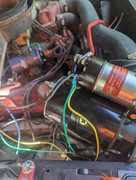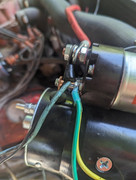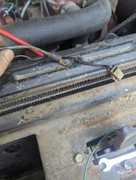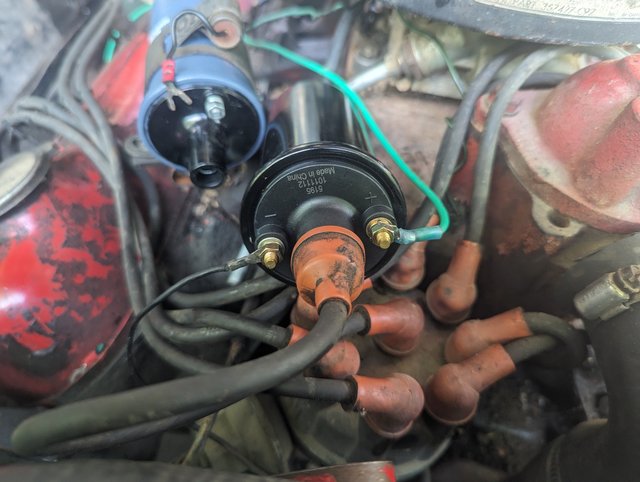im rewiring the starting aspect of my truck. got a few of the wires figured out( i think) if i can get some confirmation that would be great, ( i do have the wiring manual forthe 72 up full size but my truck is a 71 so not sure if the schematcis are going to be correct)
 Yellow wire is the the styart wire from the ign switch( was orrignaly yellow so i kept he same color) the green one is from the positive side of the coil
Yellow wire is the the styart wire from the ign switch( was orrignaly yellow so i kept he same color) the green one is from the positive side of the coil
 postive main wire off starter cylanoid (red is going to battery the black and blue is stil the original( i think that goes to cab for main power?)
postive main wire off starter cylanoid (red is going to battery the black and blue is stil the original( i think that goes to cab for main power?)
 came from the origina( i think ) alt, the black wire came from the plug on the side of the alt, the green termainal was taped up so im not sure were or what that was for(upgrading to a GM one wire alt at this time)
came from the origina( i think ) alt, the black wire came from the plug on the side of the alt, the green termainal was taped up so im not sure were or what that was for(upgrading to a GM one wire alt at this time)
 this was the orignal wires from the coil not sure what the wire did, and i am un able to trace it out.
this was the orignal wires from the coil not sure what the wire did, and i am un able to trace it out.
thank you for your time.
1971 1210 camper special 345 v8 manual trans 2wd
 Yellow wire is the the styart wire from the ign switch( was orrignaly yellow so i kept he same color) the green one is from the positive side of the coil
Yellow wire is the the styart wire from the ign switch( was orrignaly yellow so i kept he same color) the green one is from the positive side of the coil postive main wire off starter cylanoid (red is going to battery the black and blue is stil the original( i think that goes to cab for main power?)
postive main wire off starter cylanoid (red is going to battery the black and blue is stil the original( i think that goes to cab for main power?) came from the origina( i think ) alt, the black wire came from the plug on the side of the alt, the green termainal was taped up so im not sure were or what that was for(upgrading to a GM one wire alt at this time)
came from the origina( i think ) alt, the black wire came from the plug on the side of the alt, the green termainal was taped up so im not sure were or what that was for(upgrading to a GM one wire alt at this time) this was the orignal wires from the coil not sure what the wire did, and i am un able to trace it out.
this was the orignal wires from the coil not sure what the wire did, and i am un able to trace it out.thank you for your time.
1971 1210 camper special 345 v8 manual trans 2wd



